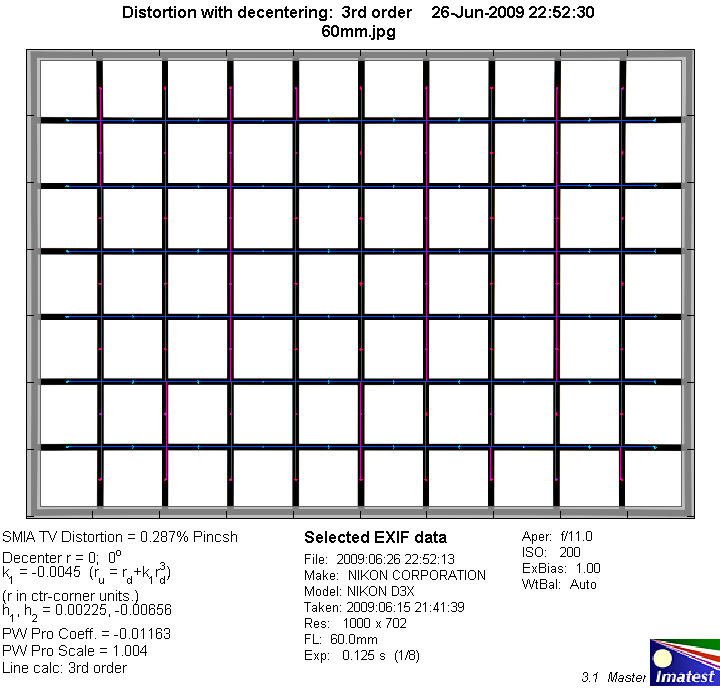|
Page 2 of 3

Distortion
As to be expected from a fix focal micro lens, the amount of distortion is very low at around 0.3%. Allthough measurable in the lab, this can certainly be regarded as free of distortion under field conditions.

The chart above has a real-world size of about 120x80cm.
Vignetting
Fast primes are expected to show visible vignetting when used at large apertures, however the amount of light falloff towards the corners at f/2.8 is surprisingly high. As usual, stopping down reduces the corner darkening considerably. From f/5.6 onwards it's no longer an issue except for really critical subjects.
We're performing our vignetting analysis based on
(uncorrected) JPEGs straight from the camera. The JPG engine of the Nikon D3x features a rather flat
gradation curve, thus has a moderate contrast characteristic, resulting in comparatively low vignetting figures - the
corresponding Canon figures are roughly 40% higher due to the more
aggressive default contrast setting.

MTF (resolution)
The center resolution is very good wide open already and reaches excellent values at f/4 already. From f/11 onwards diffraction reduces the resolution again.
The borders and corners show very good resolution at all apertures down to f/11, the borders even reach excellent figures at f/5.6 and f/8.
Please note that the MTF results are not directly comparable across the different systems!
Below is a simplified summary of the formal findings. The chart shows line widths
per picture height (LW/PH) which can be taken as a measure for sharpness.
If you want to know more about the MTF50 figures you may check out the corresponding
Imatest Explanations

Chromatic Aberrations (CAs)
Chromatic aberrations (color shadows at harsh contrast transitions) are moderate and in the range of roughly 1.7 down to 0.7 pixels, achieving the largest values wide open and slowly decreasing with smaller apertures.
CAs can easily be corrected in software or by the camera itself (if you shoot JPEGs and own a current Nikon DSLR).

Bokeh
The quality of the bokeh (out-of-focus blur) is generally very good, the lens shows only a slight amount of nervousness and double contures behind the focus plane.
Background highlights are not perfectly circular wide open towards the borders due to mechnical vignetting. Towards the image center they are prefectly cirular, however, and this is also true for the image boorder when slightly stopped down. Thanks to rounded aperture blades the highlights remain circular for most of the aperture range. Outlining is not an issue in highlights, however there are visible green shades due to bokeh fringing at large apertures (see next section).

Bokeh Fringing
Bokeh fringing is a common issue with relatively fast glass. It's visible as halos of different colors in out-of-focus areas - magenta (red + blue) in front of the focus point
and green beyond.
Typical for most fast primes, the Micro-Nikkor shows noticeable bokeh fringing at large aperture settings, which can of course be reduced by stopping down.
|